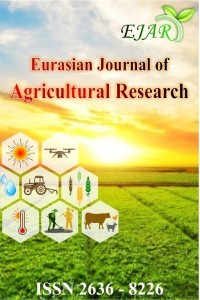The Evaluation of Kayseri, Ağırnas Traditional Houses in the Frame of Ecological Design
The Evaluation of Kayseri, Ağırnas Traditional Houses in the Frame of Ecological Design
Ağırnas, traditional settlements, traditional Anatolian houses ecological design, landscape design,
___
- Aklanoğlu, F. 2009. Geleneksel Yerleşmelerin Sürdürülebilirliği ve Ekolojik Yerleşmeler. Doktora Tezi, Ankara Üniversitesi Fen Bilimleri Enstitüsü Peyzaj mimarlığı Anabilim Dalı, 222, Ankara.
- Aklanoğlu, F. & Erdoğan, E., 2011. Sille (Konya) Yerleşiminin Sürdürülebilirliği için Ekolojik Tasarım Önerileri. Tekirdağ Ziraat Fakültesi Dergisi, 8 (2): 119-133.
- Anonymous 2016. Web Site: http://www.kayserikulturturizm.gov.tr (accessed: 15 February 2017).
- Anonymous 2017a. Web Site: http://www.haritatr.com/harita/agirnas/102685 (accessed: 10 February 2017).
- Anonymous 2017b. Web Site: https://www.google.com.tr/maps/place/Kayseri (accessed: 23 February 2017) Anonymous 2017c. Web Site:http://kayseri.tarim.gov.tr/Menu/80/Cografi-Yapi (accessed: 15 February 2017).
- Erdoğan, E. & Yıldız, N.E., 2017. Peyzaj Tasarımı ve Taş. IV. Uluslararası Taş Kongresi Özet Kitabı, 20-25 Mart, pp.62-64, İzmir.
- Okyay, A., 2007. Ağırnas Kentsel Sit Alanı ve Mimar Sinan Caddesi Üzerine Bir Araştırma. Yıldız Teknik Üniversitesi Fen Bilimleri Ensitüsü Mimarlık Bölümü Rölöve-Restorasyon Anabilim Dalı, 172, İstanbul.
- Tel Öztürk, H., 2014. Şanlıurfa Geleneksel Kent Dokusunun Ekolojik Tasarım Kapsamında Değerlendirilmesi. Doktora Tezi, Ankara Üniversitesi Fen Bilimleri Enstitüsü Peyzaj Mimarlığı Anabilim Dalı, 257, Ankara.
- Tel Öztürk, H. & Erdoğan, E. 2014. Ekolojik Yerleşmeler ve Ekolojik Yıpranma: Şanlıurfa Geleneksel Kent Dokusu ve Karaköprü İlçesi. KSÜ Doğa Bilimleri Dergisi, 17 (2): 21-32.
- ISSN: 2636-8226
- Yayın Aralığı: Yılda 2 Sayı
- Başlangıç: 2017
- Yayıncı: Muhammed Cüneyt BAĞDATLI
The Performance Assessment in Irrigation Systems: The Case of Turkey
Mehmet Akif KALENDER, Ramazan TOPAK
Effects of Heat Stress on Dairy Cattle
Ahu Alev ABACI BAYAN, Kadir YILMAZ
The Evaluation of Active Green Sites For Recreation: Bor Case
Gülden SANDAL ERZURUMLU, Nuriye Ebru YILDIZ, Barış KAHVECİ
The Evaluation of Kayseri, Ağırnas Traditional Houses in the Frame of Ecological Design
Elmas ERDOĞAN, Nuriye Ebru YILDIZ
Flaming and Burning as Thermal Weed Control Methods: A Review
Ali BOLAT, Ugur SEVILMIS, Ali BAYAT
A New Approach in Management Against Plant Fungal Disease: Host Induced Gene Silencing
A Software Development for Real Time Spray Control System in Herbicide Application
